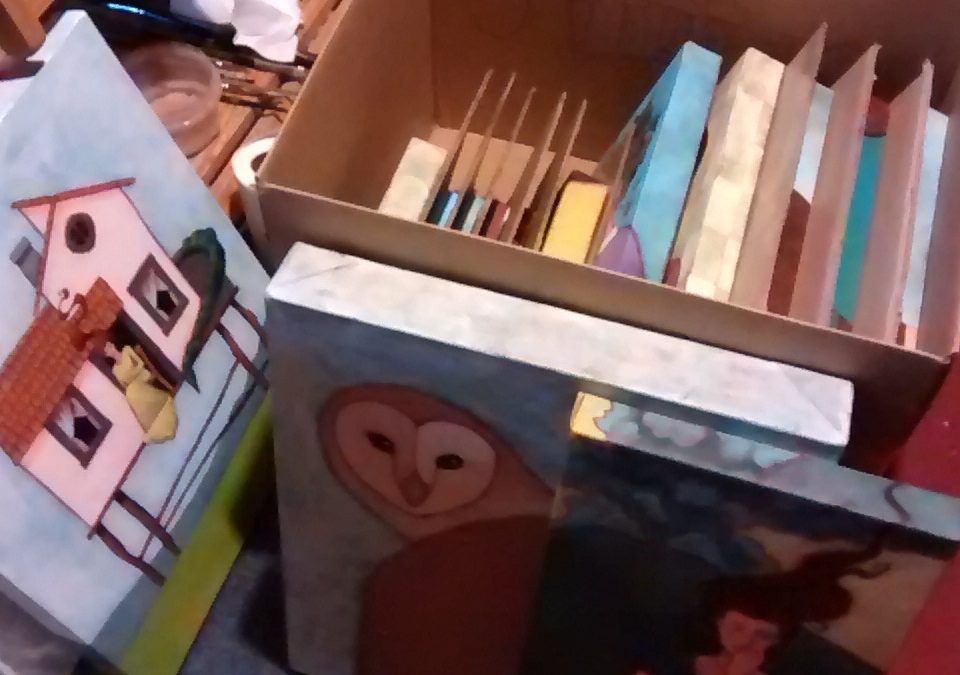My show wrapped up last Friday, and yesterday I picked my work up from the gallery! They will be sending me a check on Friday for the sale, and on Sunday I deliver a painting to its new owner.
This show was a good experience and I’m glad I had the opportunity to show at this gallery! It coincided with a neighboring gallery’s huge fundraising event, and got a LOT of foot traffic the day before it opened. So at the very least, my art was seen by a LOT of eyes.
This show was also a bit enlightening, and there were some things I think I would do differently next time.
Here’s some of what I learned.
1) Nonprofit galleries are great for emerging artists!
Helping new artists is part of these nonprofits’ mission. They’re willing to give emerging artists a chance, and (maybe more importantly) the experience of preparing for and participating in a show — something commercial galleries don’t have the time or money to invest in, because they’re looking at the bottom line and trying to make a profit. A commercial gallery is looking for a sure thing, an artist who already has a following. Nonprofits are looking to give new artists, and artists from under-served or minority communities, a chance they might not get anywhere else.

My art at the Utah Arts Festival Gallery in the May 2016 show “Person, Place, or Thing”. There’s something to be said for having a place to hang your work…!
2) Nonprofit galleries have more on their plate than running a show.
Helping new artists isn’t the end-all and be-all of a nonprofit gallery’s mission. Most of the nonprofit galleries I’ve worked with have a larger mission than just helping new artists. Yes, they’ll give you space to show your work… but running the gallery isn’t the only thing they do in a day, and their other duties will sometimes take precedence over helping gallery customers.
The gallery I showed in was an all-year extension of the Utah Arts Festival. Their main focus of the year is the festival itself, which takes place in June. So while my gallery show was up, they were busy getting the advertising and merchandise ready for the festival; coordinating the food booths and performing artists and vendors of all kinds, and setting up their plans for the space. (In fact, when I went to pick up my art, the center of the gallery had a big table in it, covered with festival materials, and the corner nearest my paintings was stacked with boxes of brochures and maps.)
3) Nonprofit galleries are trying to maximize their limited resources.
Three months ahead of my show, I called the gallery with a pressing question: what were they going to do for promotion, and should I provide high-resolution images of my work for their printed promotional material — post cards, fliers, ads and stuff?
Turns out… not much, and no.
They weren’t printing any promotional materials at all, in fact, to save on costs. They were relying solely on their social media (Facebook in particular) to get the word out. Also, they weren’t paying to promote their Facebook posts; they were counting on organic word-of-mouth sharing of their posts. Which, because of how Facebook works, turned out to be pretty small. The only shares and likes on the first post about it (which I discovered by searching for it, not because it showed up on my feed) were from my own friends and family, because I shared it on my timeline. Because I looked for it specifically.
I did give them low-res images of my new work, for their social media. And I did all I could to promote my show on my own timeline, and it paid off. I had visitors to the gallery who came because they saw me talk about it on Facebook. That made it worth it.
I also took the effort to make some postcards, on my own dime. It was not very expensive; I used my own desktop software to create a post card design and had it printed 4-up on card stock at my local copy shop. They even cut them for me. The post cards turned out fine! I mailed them out to my own list (at this point, just my friends and family) and took some around to my neighbors. It sparked some interest and got people talking to me about my work, even if they didn’t go to the show itself.
4) Relying on a nonprofit gallery’s list isn’t a guarantee of sales.
Because a nonprofit gallery’s focus is not necessarily art collectors, they may or may not have a powerful contact list. A commercial gallery’s list is full of customers, and probably other artists. And while a nonprofit gallery’s list will probably include high-end donors and philanthropists, that doesn’t necessarily mean they’re interested in collecting, and a list like that does not guarantee sales, especially for unknown artists. I was kind of hoping to lean on the gallery’s list for attendance, but that would have been a mistake.
# # #
I have more to say on what I learned from this exhibit, but that will be another post! Next time: What I did differently for this show, which improved my results…!

